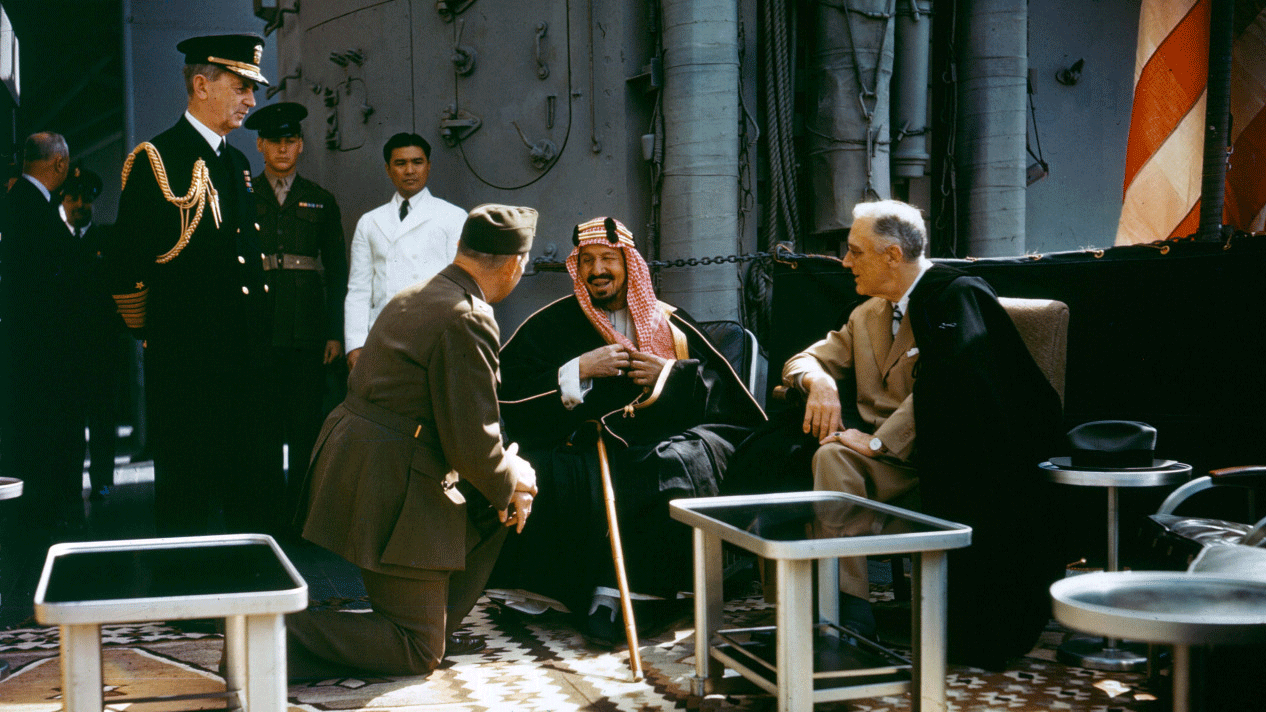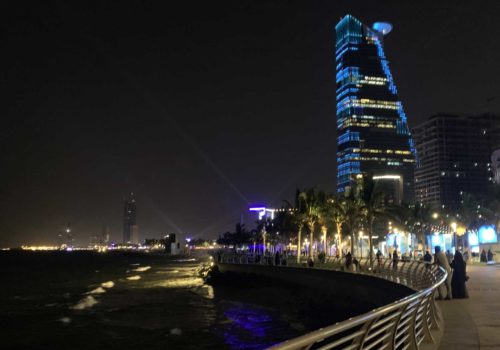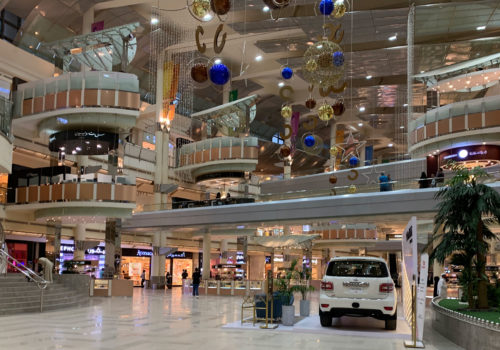BEIRUT — I recently drove to Lebanon’s southern city of Sidon, known locally as Saida, bumping across the potholes on the back roads to arrive at a neighborhood few foreigners would have reason to visit. It is a Shiite residential area in the majority Sunni city: Homes are dotted with Hezbollah flags and posters of the militant group’s smiling leader Hassan Nasrallah. But on one stretch of road, there are indications of another minority’s historic presence—a white wall had been painted with a Christmas tree, a snowman and a dove holding an olive branch.
I arrived here with the Rev. Mikhail Sbait, who serves as pastor at Saida’s Protestant church. He unlocked the black iron gate and led us into the cemetery that lies behind the wall.
It is the final resting ground for several of the American missionary families that flocked to Lebanon in the 19th century to preach the word of God, as they understood it, in the Levant. Many students of the educational institutions they founded, which remain some of the most prominent in Lebanon, are also buried here. Today it lies in disrepair, with branches and dirt covering most of the tombs: Rev. Sbait’s dwindling congregation, which numbers around a dozen families, lacks the funds to rehabilitate it.
As soon as we entered, I made a beeline to a back corner of the cemetery, where four gray stone slabs were arrayed in a row next to a small garden. I was interested in someone with a different pedigree than the religious men surrounding him. Clearing the brush off the graves and wiping away the dirt, I soon found him. His tombstone reads: William Alfred Eddy, Colonel, U.S.M.C.
William Eddy was one of the US government’s first Middle East specialists and a foundational figure in the US-Saudi alliance. He was a soldier, diplomat, academic, business consultant and a spy. His fingerprints are visible on every major event and institution that formed the alliance. I came here to better understand the foundations of the partnership between the United States and the House of Saud, and how the pioneers of US influence in the Middle East conceived of their mission.
Tools of American power
Eddy’s grave stands next to those of his wife and parents, William King Eddy and Elizabeth Nelson Eddy. He came from a long line of Presbyterian missionaries; William King Eddy was a particularly prominent figure, known for translating the Bible into Arabic and founding a school in Saida. Eddy saw his work as an extension of his forebears’ religious mission, writing near the end of his life that as an employee of Aramco, which would become the Saudi national oil company, “I have been involved as were my father and grandfather in programs of education, health, imparting skills for vocations, and extending goodwill for the U.S.A., which is the legacy of our pioneer missionaries.”
In reality, however, Eddy was an expert not in spiritual affairs but wielding the political and economic tools of American power. His contemporaries describe him as single-minded and indomitable, qualities that served him well not only in the Gulf but in his previous career as a soldier. At the height of World War I, he was badly injured by a high explosive shell while fighting to repel a German assault in northern France. Multiple doctors protested an order from the White House to bring him back to the United States, believing he would never survive the journey. When his ship eventually arrived in New York, Eddy, who was six feet tall, weighed 108 pounds—but he was very much alive.
Eddy would go on to become president of Hobart College in upstate New York during the interwar years, and would return to service as an intelligence officer during World War II. The apex of his career came in February 1945, when he arranged the meeting of President Franklin Delano Roosevelt and Saudi Arabia’s first king, Ibn Saud, on board the USS Quincy. Eddy was the second US chief of mission to reside in Saudi Arabia at the time, and by far the most important of this era. (His predecessor, James S. Moose Jr., is remembered mainly for pontificating that “Arabic is a language that opens the door to an empty room.”)
The meeting aboard the Quincy was Ibn Saud’s first personal contact with a Western leader, and Eddy served as the translator between the two aging heads of state. In the seminal photograph of the encounter, he is dressed in his military uniform and leaning courteously over Ibn Saud as the king gesticulates toward FDR—etched into history at the symbolic moment when the United States became the preeminent patron of the most powerful Arab Gulf state.

The translation work was the easy part for Eddy, a fluent Arabic speaker. His real challenge was to navigate the cultural and religious chasms separating the Saudis and Americans. It was no simple task: The meeting had to be held in secret, given the real threat still posed by Nazi Germany, and Ibn Saud had to be afforded the regal privileges he enjoyed in Saudi Arabia while aboard an American warship. The king initially wanted to bring 200 people, including his harem, aboard the USS Murphy, which would transport him to the Quincy; Eddy negotiated that number down to 48 people, excluding women entirely. The king also brought seven live sheep, as he required halal meat every day, although Eddy convinced him it would be impossible for the American sailors to eat from his table as regulations specified that those who consumed anything but US Navy rations would be thrown in the brig.
Eddy also had to manage relations with the sons of Ibn Saud who had made the journey with their father. Two young princes demanded to see a bawdy film starring Lucille Ball, “Best Foot Forward,” which was being shown for the American sailors; in one scene, Ball’s dress is ripped off in a men’s dormitory. Ibn Saud was also shown his first film, “The Fighting Lady,” about an American aircraft carrier’s exploits against the Japanese navy. The king would say that he enjoyed the film, but “I doubt whether my people should have moving pictures even like this wonderful film because it would give them an appetite for entertainment which might distract them from their religious duties.”
If the success of the meeting aboard the Quincy had been the only accomplishment in Eddy’s professional life, he would be remembered as an unusually talented soldier-turned-diplomat. However, it was only one chapter among many. His career after the conclusion of World War II is if anything more interesting, and serves to show how business and intelligence efforts often went hand in hand with overt political action to bolster US influence in Saudi Arabia.
Muzzling opposition
In 1946, Eddy left the Middle East and returned to Washington DC to work for the State Department. Drawing on his experience during World War II with the Office of Strategic Services (OSS), he helped draft the legislation that enabled the creation of its successor the Central Intelligence Agency. Eddy would maintain ties to the CIA for the rest of his life even as he kept that part of his work hidden from the top ranks of the Saudi leadership and other US partners in the Arab world.
To the public, Eddy left government service and joined Aramco, the massive US company that had won the concession in the 1930s to drill for oil in Saudi Arabia. Eddy would describe his role as a “Middle East consultant.” In fact, he continued to work for the CIA even while employed by Aramco, coordinating efforts by the company and the US government to secure their economic and political interests in Saudi Arabia and the wider Arab world.
The question facing Saudi Arabia and the United States is not how quickly both countries will reap the benefits of the oil boom, but whether their political and economic partnership has reached its limits.
Those efforts included attempts to convince the Arab world’s elite, by deceit if necessary, of the necessity of the US-Saudi alliance. In 1948, Eddy wrote to his wife of an Aramco plan to disseminate letters, “written as though an Arab were writing,” to prominent Arab politicians that “describe the tremendous development in Arab lands which can take place in the next few years by private capital, British and American.” The letter went on to argue that the wealth that will accrue to Arab nations from the entry of Western corporations “will arm them economically to withstand expanding Zionism.”
Eddy’s efforts also aimed to weaken prominent Saudi officials who were viewed as hostile to US goals in the region and promote those viewed as more pliant. In 1951, he wrote to his wife that the Saudi finance minister, Abdullah Sulayman, “is again drinking heavily” and “told the king a pack of lies” about Aramco, putting the firm’s position in jeopardy. Eddy would later coordinate with the US government to promote then-Crown Prince Saud bin Abdulaziz as a modernizing reformer and convince the soon-to-be king to remove Sulayman from his position.
Advancing Aramco and the US government’s interests, however, involved political efforts that extended far beyond Saudi Arabia’s borders. The Trans-Arabian Pipeline (Tapline), the world’s largest oil route at the time, used to deliver Saudi oil from the eastern shores of the kingdom to the Mediterranean. It extended over 700 miles, receiving oil from the fields at Abqaiq—the site of the recent Iranian attack on Saudi Arabia’s oil infrastructure—and terminating only a few miles from the area that now constitutes William Eddy’s final resting place. In the early 1950s, 78 percent of Saudi and Iraqi crude passed through the pipeline before heading to Western Europe.
As the pipeline grew in prominence, its preservation became a US national security concern. It was Eddy’s job to promote both American economic and political interests in Lebanon around the issue. The pipeline had become a political flashpoint in Beirut, with opponents of President Camille Chamoun pressing for Aramco to pay greatly increased transit fees to keep the oil flowing. Eddy worked to strengthen Chamoun’s resolve, castigating him for weakness in failing to muzzle political opposition to the Tapline arrangement. That skirmish drew the United States closer to Chamoun and the Christian Maronite establishment that he represented, serving as a prelude to the 1958 US Marine landing in Beirut, when Eddy’s former comrades-in-arms helped to put down an uprising by Chamoun’s Muslim and Druze rivals.
Return to better times?
Despite that history, it is not uncommon for my Saudi friends to hearken back to the halcyon days of the US-Saudi alliance, comparing the earlier era favorably to the current day. The popular impression, expressed to me by Saudis young and old alike, is that the United States was a true friend of the kingdom in days past. The two countries worked together, the argument goes, to forge an alliance that expanded the power and wealth of both.
There is an element of truth in this narrative, and it doesn’t only have to do with the world of high politics. My Saudi friends place a great emphasis on the cultural and commercial linkages between their country and the United States. While Saudi Arabia might seem distant and foreign to most Americans, the United States is omnipresent in the lives of many Saudis—I have never before experienced an Arab country as saturated in American culture. Within walking distance of my apartment in Riyadh is an Applebees, Starbucks and a Chili’s restaurant; American chain stores exist even in far-flung cities and towns. Saudis watch American movies, follow the lives of American celebrities and watch American news. For that reason, the recent wave of criticism directed at the kingdom from US media and officials is perceived not just as a shift in a political alliance, but a rejection by a country that has played a central role in shaping the kingdom’s economy and culture.

Of course, it is also true that the two countries’ military alliance has helped shape the Middle East. The United States took Saudi Arabia’s side in military confrontations ranging from the 1956 Suez Crisis to the 1991 Gulf War, and the two countries were allied against the Soviet Union during the Cold War.
The history of William Eddy adds nuance to this nostalgic understanding of the past, however. From the beginning, the Americans were out for themselves—as were the Saudis. Eddy’s first task aboard the USS Quincy was to secure US primacy in Saudi Arabia over regional rivals, chief among them Great Britain. His second task, operating from Dhahran and Beirut, was to ensure the maintenance of a political order that would allow US firms to pump the maximum amount of oil from under the soil of the kingdom, while handing over a minimum amount of the revenue to the coffers of Saudi Arabia and other Arab governments.
Perhaps the main difference between the previous era and the modern US-Saudi alliance is the increasingly public nature of politics. Eddy operated largely behind the scenes, mustering American military, economic and intelligence assets to advance his political goals. US political leaders weren’t signing agreements with Saudi Arabia’s main geopolitical rivals on national television or pontificating on cable news about the kingdom’s human rights record.
However, I think there’s more to the story than that. Saudi oil production began to take off after World War II: Aramco pumped 540,000 barrels of crude oil per day in 1950, a figure that rose nearly six-fold to almost 3 million barrels a day by 1969. Saudi infrastructure was developing at a breakneck pace, fueled by the oil revenue, as the country built the trappings of a modern state. Yes, Eddy and his associates were maneuvering to take as large a slice of the pie as they could—but there was more than enough wealth to go around.
Today, the question facing Saudi Arabia and the United States is not how quickly both countries will reap the benefits of the oil boom, but whether their political and economic partnership has reached its limits. Aramco was nationalized decades ago, and the Saudi government is now grappling with the reality that the benefits its oil revenues can provide the population are steadily deteriorating. On a political level, Saudi officials perceive their traditional sphere of influence in countries such as Lebanon, Syria, Iraq and Yemen to be under assault by Iran, with the United States doing little or nothing to stem Tehran’s influence.
The assault on the Aramco infrastructure in Abqaiq has exacerbated what many Saudis to whom I have spoken see as the rift in the alliance. First, there is a sense that the US government has not done its part in assuring Saudi security. The “original sin,” in their eyes, is President Barack Obama’s nuclear deal with Iran, but they do not perceive a significant improvement in support under President Donald Trump’s leadership. Trump’s response to the attack—initially saying the United States was “locked and loaded” and then quickly backing away from military involvement—was seen as an example of his preference for rhetoric over action.
In other words, much has changed about the world since William Eddy helped forge the US-Saudi alliance almost three quarters of a century ago. Even if both parties want to recreate the partnership that did so much to shape the latter half of the 20th century in the Middle East, there may be no going back to the way things were.
Banner photo: The apex of William Eddy’s career came in February 1945, when he arranged a meeting of President Franklin Delano Roosevelt and Saudi Arabia’s first king, Ibn Saud, on board the USS Quincy. He is shown here kneeling, translating for the King Saud (source: US Navy Photo)




